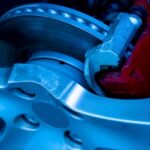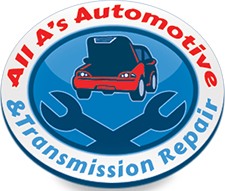All About Auto Brake Maintenance: Fall Car Care

 Fall is an excellent time for routine auto brake maintenance. Autumn’s wetter weather and frosty nighttime temperatures can create more challenging driving conditions. Keep yourself, your family, and fellow motorists safe this fall. Schedule auto brake maintenance so your Midland, MI technician can check for worn brake pads (or shoes), damaged rotors, and low brake fluid levels.
Fall is an excellent time for routine auto brake maintenance. Autumn’s wetter weather and frosty nighttime temperatures can create more challenging driving conditions. Keep yourself, your family, and fellow motorists safe this fall. Schedule auto brake maintenance so your Midland, MI technician can check for worn brake pads (or shoes), damaged rotors, and low brake fluid levels.
What Is Auto Brake Maintenance?
Auto brake maintenance involves routine inspections of brake components and fluid levels, including all necessary repairs and parts replacement. If you have the required skills and tools, you can perform brake maintenance on your vehicle at home. You can also schedule a brake service appointment with your trusted auto service center.
Disc Brakes Components
Disc brakes work via friction to slow and stop your vehicle. The calipers hydraulically press the brake pads against the spinning rotor, creating friction (and heat). Friction between brake pads and the rotor (also called a disc) slows the spinning motion. These components require periodic inspections and occasional maintenance and replacement.
Brake Pads
Brake pads wear out over time and need periodic replacement. The time interval for brake pad replacements can vary depending on your driving style, vehicle type, and driving conditions. Brake pads consist of different materials and fall into three basic categories:
- Ceramic
- Organic
- Semi-metallic
The brake pad type can impact its lifespan and effectiveness. Always use the specific type your auto manufacturer recommends.
Rotors
Brake rotors are flat metal discs (often with cooling vents or holes) attached to the wheel hub. The rotors spin with the wheel as the vehicle moves. Direct pressure from the brake pads against the rotors is what slows and stops your automobile’s momentum. This pressure creates friction and heat during braking. Excess amounts of friction and heat speed up the wear on brake components. Too much heat can warp and damage the brake rotors. Rotor maintenance can include resurfacing and replacement.
Calipers and Pistons
Brake calipers fit over the rotor and house the brake pads and pistons. They operate via brake fluid pressure (hydraulics) when the driver engages the brake pedal.
Drum Brakes Components
Drum brakes are an older braking system but are still used in some modern vehicles as rear brakes, with disc brakes in the front. They consist of a hollow drum attached to the wheel, featuring an open back covered by a stationary backplate with two curved brake shoes. When a driver engages the brake pedal, hydraulic pressure supplied by the pistons in the brake’s wheel cylinders move the shoes outward against the inside of the drum. This action produces friction, reducing the wheel’s momentum to slow and stop your vehicle. These components require periodic inspections and occasional maintenance and replacement.
Brake Drum
The brake drum is usually cast iron or aluminum with a cast iron liner. The drum provides the surface the brake shoes rub against when the brake pedal is engaged. When brake shoes press against the drum, friction and heat are generated. Brake drums often have cooling fins to help absorb and dissipate excess heat so the brake shoes do not get too hot. Additionally, the drum protects the internal brake components from road debris, dirt, and water.
Brake Shoes
Brake shoes use friction against the drum to provide stopping power. As the brake shoe heats up once in contact with the brake drum, it transfers a tiny amount of its material to the drum. The drums and shoes will then have more friction and sort of ‘stick’ to each other, providing enough drag to slow and stop your vehicle.
Brake shoes often contain both metallic and organic materials, adhered together by pressure and intense heat.
Master Cylinder & Wheel Cylinders:
The brake pedal connects to pistons in the master cylinders and then to individual cylinders at the wheels. As the pistons move outward, they press the brake shoes against the inner plane of the brake drum attached to the wheel through hydraulic force.
Regenerative Brakes
Regenerative brakes are most effective in stop-and-go driving conditions. They also use the power that drives the vehicle to brake. When you engage the brake pedal of an electric (EV) or hybrid vehicle (HEV), regenerative brakes put the vehicle’s electric motor into reverse mode (making it run backward), which slows the wheels. While the motor runs backward, it behaves like an electric generator, producing electricity to store in the vehicle’s batteries.
Most hybrids and electric vehicles also have traditional friction brakes that engage when regenerative braking doesn’t provide adequate stopping power. Since vehicles with a regenerative braking system also use a type of friction brakes, those components require inspections and service just like any other car. Plus, several electronic components and sensors may require inspection.
Brake Controller
A regenerative braking controller is similar to an ABS controller. They monitor the wheel’s rotational speed and the difference between that speed and the other wheels. The brake controller also calculates how much rotational force (or torque) generates electricity back to the batteries.
Brake Fluid
Brake fluid is a hydraulic liquid that conducts the force from the brake pedal to the components at each wheel. It also absorbs heat, prevents rust & corrosion, and prevents excess friction from damaging the braking system components. Finally, it’s hygroscopic, which means it attracts and absorbs water molecules, encapsulating them so they can’t corrode the metal parts.
In a properly maintained system, brake fluid can last a long time. However, low fluid can create a snowball effect, where excess heat can burn the fluid, causing it to be less effective at its job. Old, worn-out brake fluid requires replacement with fresh stuff to protect your vehicle’s braking system.
Factory-Suggested Brake Maintenance Intervals
As a responsible car owner, it’s our duty to follow the auto manufacturer’s maintenance guidelines to maintain our vehicle’s safety, performance, and operational standards. The braking system is one of our vehicle’s most important safety features. And since we know that the components wear out over time, it’s vital to schedule routine brake inspections and service promptly.
Disc Brakes
Brake pads contain ‘wear indicators’, which produce a squealing sound once they wear down enough to require replacement. Once your brakes start squealing, schedule a brake service appointment for pad replacement. Ignoring the sound can result in damage to the rotors and create a more costly repair down the road.
Brake Pads: In general, they last between 25,000 and 70,000 miles.
Brake Rotors: They often last 50,000 to 70,000 miles (and sometimes more). They can become damaged if they overheat or when the brake pad replacement is overdue.
Calipers and Pistons: They often last the lifetime of the vehicle. Exceptions include:
- Mechanical problems due to rust, corrosion from road salts, or inactivity
- Damage from road debris
- Auto collisions or fender-benders
Brake Fluid: Inspect fluid levels every 24,000 to 36,000 miles or immediately if you see leaking brake fluid.
Drum Brakes
In general, rear drum brakes last longer than typical disc brakes. A good rule of thumb is to schedule a brake inspection every 6 months to check for proper lubrication, excessive corrosion or rust, and calibration. However, keep in mind that driving conditions, weather, and driving style can drastically affect service intervals. If your brakes feel different, or if it takes longer to come to a complete stop, schedule a brake inspection service immediately.
Brake Shoes: They can last 25,000 to 30,000 miles but may require more frequent replacement.
Master Cylinder & Wheel Cylinders: The master cylinder can last as long as the car does but should be inspected every 60,00 to 100,000 miles. The seals in the master cylinder get dry and brittle over time, allowing brake fluid to leak.
Brake Drums: They can last up to 150,000 miles before requiring refurbishment or replacement. However, use in locales with frequent road salt may find corrosion an issue requiring more frequent service, cleaning, and lubrication.
Regenerative Brakes
Electric and hybrid vehicles are constantly evolving, so no steadfast brake service schedule applies to all of them. Consult your vehicle’s owner’s manual to find the factory-recommended service interval for your vehicle’s regenerative brakes.
Brake Fluid
Brake fluid service intervals vary widely from car to car. Some need inspecting every 15,000, while others have ‘lifetime’ fluid, only suggesting service every 120,000 miles. To find the correct brake fluid service schedule for your vehicle, read your owner’s manual and discuss your needs with your auto service technician. If you suspect your brake fluid is low, check the levels immediately. Leaking and low brake fluid may cause complete brake failure, so schedule a brake service to find and repair the issue.
Brake Maintenance In Midland, MI
At All A’s Automotive & Transmission Repair, our certified technicians provide expert service at a reasonable price. Call today for more information about our 24-month / 24,000-mile nationwide warranty. We’re your local family-owned independent auto maintenance service center and dealer alternative. We can quickly inspect your brake pads, rotors, and brake fluid levels and get you safely on the road again.
Schedule Brake Maintenance Service
Located at 1300 S. Poseyville Rd., Midland, MI 48640.
Call (989) 631-4672 or visit our website to schedule your next brake maintenance service appointment.
Posted in: Brakes
Leave a Comment (0) ↓
